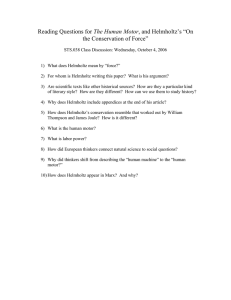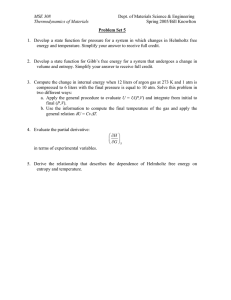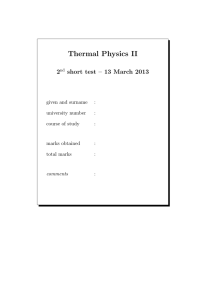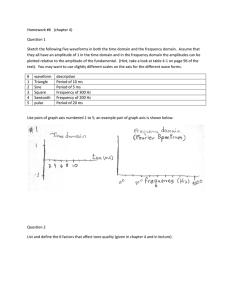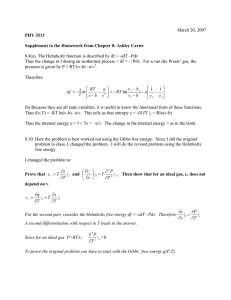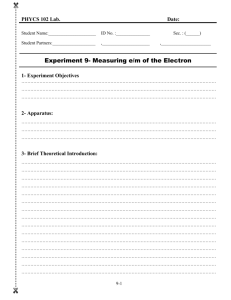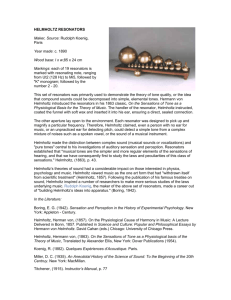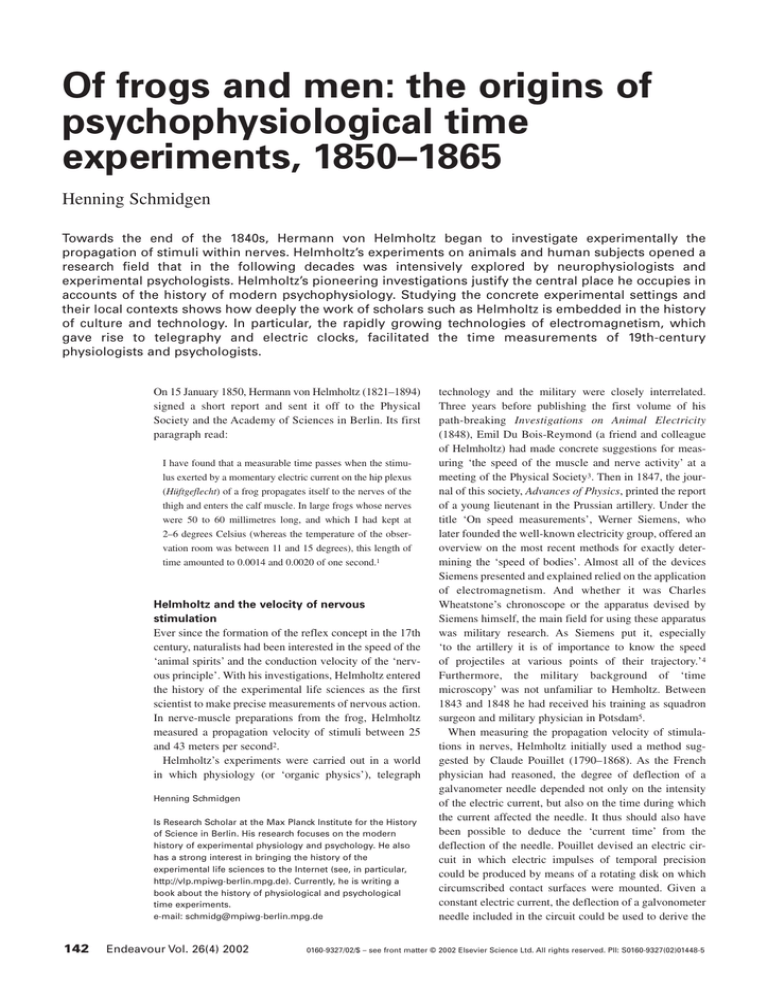
Of frogs and men: the origins of
psychophysiological time
experiments, 1850–1865
Henning Schmidgen
Towards the end of the 1840s, Hermann von Helmholtz began to investigate experimentally the
propagation of stimuli within nerves. Helmholtz’s experiments on animals and human subjects opened a
research field that in the following decades was intensively explored by neurophysiologists and
experimental psychologists. Helmholtz’s pioneering investigations justify the central place he occupies in
accounts of the history of modern psychophysiology. Studying the concrete experimental settings and
their local contexts shows how deeply the work of scholars such as Helmholtz is embedded in the history
of culture and technology. In particular, the rapidly growing technologies of electromagnetism, which
gave rise to telegraphy and electric clocks, facilitated the time measurements of 19th-century
physiologists and psychologists.
On 15 January 1850, Hermann von Helmholtz (1821–1894)
signed a short report and sent it off to the Physical
Society and the Academy of Sciences in Berlin. Its first
paragraph read:
I have found that a measurable time passes when the stimulus exerted by a momentary electric current on the hip plexus
(Hüftgeflecht) of a frog propagates itself to the nerves of the
thigh and enters the calf muscle. In large frogs whose nerves
were 50 to 60 millimetres long, and which I had kept at
2–6 degrees Celsius (whereas the temperature of the observation room was between 11 and 15 degrees), this length of
time amounted to 0.0014 and 0.0020 of one second.1
Helmholtz and the velocity of nervous
stimulation
Ever since the formation of the reflex concept in the 17th
century, naturalists had been interested in the speed of the
‘animal spirits’ and the conduction velocity of the ‘nervous principle’. With his investigations, Helmholtz entered
the history of the experimental life sciences as the first
scientist to make precise measurements of nervous action.
In nerve-muscle preparations from the frog, Helmholtz
measured a propagation velocity of stimuli between 25
and 43 meters per second2.
Helmholtz’s experiments were carried out in a world
in which physiology (or ‘organic physics’), telegraph
Henning Schmidgen
Is Research Scholar at the Max Planck Institute for the History
of Science in Berlin. His research focuses on the modern
history of experimental physiology and psychology. He also
has a strong interest in bringing the history of the
experimental life sciences to the Internet (see, in particular,
http://vlp.mpiwg-berlin.mpg.de). Currently, he is writing a
book about the history of physiological and psychological
time experiments.
e-mail: schmidg@mpiwg-berlin.mpg.de
142
Endeavour Vol. 26(4) 2002
technology and the military were closely interrelated.
Three years before publishing the first volume of his
path-breaking Investigations on Animal Electricity
(1848), Emil Du Bois-Reymond (a friend and colleague
of Helmholtz) had made concrete suggestions for measuring ‘the speed of the muscle and nerve activity’ at a
meeting of the Physical Society3. Then in 1847, the journal of this society, Advances of Physics, printed the report
of a young lieutenant in the Prussian artillery. Under the
title ‘On speed measurements’, Werner Siemens, who
later founded the well-known electricity group, offered an
overview on the most recent methods for exactly determining the ‘speed of bodies’. Almost all of the devices
Siemens presented and explained relied on the application
of electromagnetism. And whether it was Charles
Wheatstone’s chronoscope or the apparatus devised by
Siemens himself, the main field for using these apparatus
was military research. As Siemens put it, especially
‘to the artillery it is of importance to know the speed
of projectiles at various points of their trajectory.’4
Furthermore, the military background of ‘time
microscopy’ was not unfamiliar to Hemholtz. Between
1843 and 1848 he had received his training as squadron
surgeon and military physician in Potsdam5.
When measuring the propagation velocity of stimulations in nerves, Helmholtz initially used a method suggested by Claude Pouillet (1790–1868). As the French
physician had reasoned, the degree of deflection of a
galvanometer needle depended not only on the intensity
of the electric current, but also on the time during which
the current affected the needle. It thus should also have
been possible to deduce the ‘current time’ from the
deflection of the needle. Pouillet devised an electric circuit in which electric impulses of temporal precision
could be produced by means of a rotating disk on which
circumscribed contact surfaces were mounted. Given a
constant electric current, the deflection of a galvonometer
needle included in the circuit could be used to derive the
0160-9327/02/$ – see front matter © 2002 Elsevier Science Ltd. All rights reserved. PII: S0160-9327(02)01448-5
Figure 1. In the 19th century, most of the procedures to
measure short time intervals were developed within the
context of military research. Their primary use was
measuring the velocity of projectiles at different points of
their trajectories. With the advent of telegraph technology in
the late-1830s, electromagnetism began to play an important
role in this kind of precision measurement. The Figure shows
the use of such a time measuring device in the context of
ballistics. Its basic mechanism was suggested by the French
physicist Claude Pouillet in 1844. The deflection of a
galvanometer needle served to measure the time during
which the current was active. In this set-up, firing the rifle
opened the current which was closed again by the bullet
cutting the wire at the rifle‘s muzzle. In the late-1840s,
Hermann von Helmholtz adopted Pouillet‘s method for
measuring the propagation speed in the nerves. Reproduced
from Ref. 30.
time during which the current was active. Pouillet compared this procedure to the ballistic pendulum Benjamin
Robbins had constructed some hundred years previously6.
No wonder then that contemporary handbooks of electromagnetism displayed figures illustrating the use of
Pouillet’s method for ballistic purposes (Figure 1).
In his experiments on the propagation of nerve stimulations, Helmholtz adopted Pouillet’s ‘means to measure
extremely short time intervals’ for physiological use.
Helmholtz devised two interconnected electric circuits,
one to stimulate the nerve-muscle preparation, the other
to measure the current time by means of a galvanometer.
Both circuits could be closed in such a way that the preparation was electrically stimulated and the electric current
was simultaneously sent through the galvanometer. When
the muscle then started contracting, the current in the
galvanometer circuit was immediately and permanently
interrupted. From the deflection of the needle, Helmholtz
could read off the time the muscle needed to contract after
stimulation. Placing the electrode at different parts of the
nerve-muscle preparation, the differences in the results
obtained allowed him to calculate the propagation speed
of the ‘nervous impulse’ (Figure 2).
This, however, was only the initial form of Helmholtz’s
experiments. In the extended investigations he carried out
after his first report, Helmholtz adopted other methods for
his time measurements, turning to graphical procedures.
But when devising his famous ‘frog myographion’, he
again relied on existing precision technologies – this
time, the indicator tools used by steam engineers7.
Helmholtz’s psychological experiments
Amongst historians of biology, it is understood that
Helmholtz’s work on the propagation speed of nervous
stimuli constitutes the beginning of a branch of research
that, in the following years and decades, became known
Figure 2. This contemporary reconstruction shows the use
Helmholtz made of Pouillet‘s method for measuring the
propagation speed of electric stimuli in the nerve. The set-up
combined two electric circuits: one in which the battery, R, by
passing through the induction spirales I1 and I2, could
momentarily stimulate the nerve muscle preparation N/M; the
other circuit connected the galvanometer T to the battery Z.
The switch S/P allowed closure of both electric circuits at
exactly the same time. The devices within the metallic frame
A guaranteed that after the contraction of the frog muscle the
time-measuring circuit was permanently interrupted. By
placing the electrode at different points of the nerve (n1, n2),
Helmholtz could deduce the time the nerve needed for the
conduction of the stimulus. Reproduced from Ref. 31.
as ‘nerve and muscle physics’ and, in more recent times,
has been labeled ‘neurophysiology’. Scholars such as
Gabriel Gustav Valentin and Albert von Bezold,
Julius Bernstein and Étienne Jules Marey, and Keith
Lucas and Edgar Douglas Adrian contributed significantly to this field. Less widely known is the fact that
Helmholtz was interested in the time relations structured
by the nervous systems of living beings not just from a
physiological but also from a psychological point of
view8. In fact, at the time at which he performed his studies on frogs, Helmholtz carried out similar experiments in
human beings. Again, Helmholtz’s aim was to measure
the stimulation propagation in the sensory nerves.
In comparison with his frog experiments, Helmholtz’s
work on humans presented special challenges. For obvious reasons, the experiments could not be conducted on
preservable preparations separated from the rest of the
organism. Helmholtz tried to circumvent this difficulty by
measuring what today’s psychologists would call ‘simple
reaction times’. In a communication to the Physical
Society signed by Helmholtz on 15 December 1850, he
reported on ‘experiments on the propagation speed of
stimuli in the sensory nerves of human beings’, and
described the basic structure of his experiments:
In a human being, a very weak electric shock is applied to a
limited space of skin. When he feels the shock, he is asked
to carry out a specific movement with the hand or the teeth,
interrupting the time measurement as soon as possible.9
When all parameters remained constant, Helmholtz found
in the results of these experiments a ‘surprising constancy’. As he reported to the Physical Society almost one year
after his first paper, the results of repeated experiments in
Endeavour Vol. 26(4) 2002
143
Figure 3. In 1861, the Neuchâtel-based astronomer Adolphe Hirsch was the first
scholar to use a Hipp chronoscope for measuring the ’physiological time‘ of human
beings. Following Hirsch‘s model, experimental psychologists began to make
ample use of the Hipp chronoscope within their laboratories, especially between
1880 and 1900. In his seminal Principles of Physiological Psychology (1874),
Wilhem Wundt recommended the Hipp chronoscope for carrying out psychological
’reaction experiments‘. Reproduced from a Peyer and Farager trade catalogue,
advertising the chronoscope in 1900. The advanced model retailed at 525 francs.
different subjects oscillated between a mean of 0.12 and
0.20 seconds. Within each series, however, there was only
a ‘probable error’ of 0.003 seconds10. The relative homogeneity of measurements seemed to be a good precondition
for deducing the duration of single aspects of the reaction
process from the ‘sums’ of reaction times Helmholtz
obtained. In other words, the Königsberg physiologist
could start systematically to change single parameters of
the experimental set up, holding the other parameters constant or at least assuming that they remained constant.
Before Helmholtz started these experiments, he had
hypothesized distinct aspects or phases of the reaction
process he observed. This was facilitated by the telegraphic metaphor used by Helmholtz and many of his
contemporaries11. Thus, he explained that one part of the
time between stimulation and reaction was consumed
by the ‘sending of the signal’ (i.e. the stimulus) through
the sensory nerves. Another portion of time (which
Helmholtz assumed to be exactly as small or large as the
first) was needed to transmit the ‘message’ through the
motor nerves to the muscle. The remaining bit, Helmholtz
concluded, was the time required ‘in the brain for the
processes of perceiving and willing’9.
144
Endeavour Vol. 26(4) 2002
The concrete procedure Helmholtz then used was to
stimulate the human body in different places (e.g. in the
foot and the neck) and to derive the speed of the propagation of the stimulus within the sensory nerves from the
differences in the results obtained. Helmholtz assumed
‘that, as to their duration, the brain processes of perceiving and willing do not depend essentially from the position of the skin part that was hit’. In this perspective, it
seemed to be plausible that the stimulation of different
skin regions of the human body only altered ‘the first
link’ of the reaction chain (i.e. the propagation in the
sensory nerves)9.
The results Helmholtz obtained showed that the propagation of stimulations in the human sensory nerves were
approximately twice as fast as those in the frog. As he
explained in his communication to the Physical Society,
the difference between the time needed to react to a stimulation of the big toe and the time needed to react to a
stimulation of the sacrum suggested a stimulation speed of
62.1 meters per second. Comparing the reactions to finger
stimulations with those to stimulations of the neck gave a
result of 61.0 meters per second12. Helmholtz concluded
that in humans, the ‘message of an impression’ propagates
itself ‘to the brain with a speed of circa 60 Meter (180 feet)
[per second] and does not differ noticeably at various
times.’9 Helmholtz also reasoned that the time needed
‘by the brain for the processes of perceiving and willing’
was 0.1 seconds.
He had to admit, however, that his experiments with
humans involved a factor apt to threaten the required constancy of all others, namely the attention of the subject
under experimentation. ‘Slight feelings of sickness’ and
‘fatigue’ of the experimental subject could significantly
disturb the precision measurements, as well as distractions of all kinds: ‘If at the time of perceiving the
signal the thoughts are occupied with something else, and
if the mind has to recall to itself what kind of movement
one must carry out, it [the reaction] takes much more
time.’ At this point, Helmholtz had definitely reached
psychological ground13.
Adolphe Hirsch and the Hipp chronoscope
With his transition from frogs to human beings and the
introduction of the variation and subtraction method,
Helmholtz opened a research field that for a while was
explored by individual researchers coming from different
subject areas. As is well-known, it was only in the late1870s that scholars such as Wilhelm Wundt in Leipzig,
Alfred Binet in Paris and Edward B. Scripture at Yale
University started to consolidate and expand this field at
both the institutional and disciplinary level, contributing to
a growing ‘physiological’ or ‘experimental psychology’.
Besides the German ophthalmologist Rudolph
Schelske14, the German–Swiss astronomer Adolphe
Hirsch, director of the State observatory at Neuchâtel,
was one of the first individuals after Helmholtz to publish
a study on the speed of ‘nervous conduction’. The background for Hirsch’s investigation was scientific and at the
same time technological and economical. In 1858, the
Neuchâtel observatory was founded with the explicit aim
of providing the clock makers in the Jura Mountains with
precise measurements of time. As a well-trained
astronomer, Hirsch was aware that individual observation
errors affected the registering of star passages that were
required for astronomical time determinations. Since the
early 19th century, astronomers had become increasingly
aware that individual differences between observers
could result in significant measurement errors. But Hirsch
was not just interested in the problem of the so-called
‘personal equation’. Ever since his student days in
Heidelberg, where he had studied with the famous naturalist Friedrich Gustav Henle (1809–1885) amongst others, Hirsch had also been fascinated with physiology.
With Emil Du Bois-Reymond, whose father came from
Neuchâtel, Hirsch maintained an intense correspondence
often focusing on physiological questions.
In his 1862 publication on the topic, Hirsch renamed
the ‘sum’ Helmholtz had spoken of with respect to the
time ‘between the stimulation and the beginning of the
movement’ as ‘physiological time’15, a term Wilhelm
Wundt would adopt when publishing the first textbook
on the emerging discipline of psychology, Principles of
Physiological Psychology (1874)16. Of even more consequence for the history of experimental psychology was
Hirsch’s use of an instrument that was far easier to handle than the Pouillet method used by Helmholtz: the
Hipp chronoscope (Figure 3). Hirsch had borrowed this
precision time-measuring device personally from the
instrument maker Matthäus Hipp (1813–1893).
In the early 1860s, Hipp, the former director of the
Federal Telegraph Institution in Bern, had moved to
Neuchâtel, where he founded his own private telegraph
factory (Figure 4). Hipp had equipped the Neuchâtel
observatory with all the telegraphic apparatus Hirsch
needed for communicating time signals to the clock makers’ workshops in the Jura Mountains and to the telegraph
office in Neuchâtel. Starting in June 1860, all the telegraph
offices in Switzerland received the time signal from
Hirsch’s observatory, thus establishing a vast landscape of
distributed standard time17.
As early as the late-1840s, the Hipp chronoscope had
been presented to the public. This ‘time seer’ was an electromagnetically controlled mechanical clock that could
measure short time intervals with a precision of up to
1/1000 of a second. Hipp’s instrument was based on
Wheatstone’s chronoscope, and like Wheatstone, Hipp
thought that his chronoscope was potentially of major
interest to the military. In 1849, the chronoscope was
presented as an instrument ‘to measure the time of falling
bodies and for experiments on the velocity of shotgun
bullets.’18 However, it was the first of the suggested uses
that actually played a role in applying the chronoscope
during the 1850s. Physicists such as Friedrich Reusch and
Wilhelm Eisenlohr used the Hipp chronoscope to verify
Galileo’s laws of falling bodies19.
When Hirsch published his Chronoscopic Experiments
on the Speed of Sensory Perception and the NerveConduction in 1862, he stressed that research on the
propagation speed of stimuli within the nerves of living
organisms was, properly speaking, the task of the physi-
Figure 4. This drawing shows the Neuchâtel telegraph factory founded by Matthäus
Hipp in 1862. Hipp constructed many of the chronoscopes used by time-measuring
physiologists and psychologists in the late-19th century. Hipp‘s main business was
the production of telegraphic apparatus and electric clocks. In the late-1850s, Hipp
provided the telegraphic installations for the Neuchâtel observatory, allowing its
director, Hirsch, to send precise time signals to the workshops of the clock makers
in the nearby Jura Mountains. In 1860, all the telegraph offices of Switzerland
received daily time signals from the Neuchâtel observatory. Shortly afterwards,
Hipp installed an electric clock system in the city of Neuchâtel, serving to distribute
observatory time throughout the public buildings and places of the city. Similar
clock systems were delivered by Hipp to Zurich, Rome and other cities. Reproduced
from a drawing (ca. 1929/1930) from the sketchbook of the Swiss artist Léopold
Gern, Museum of Art and History, City of Neuchâtel.
ologist. Following the model given by Helmholtz,
Hirsch carried out his own experiments on the topic,
with human beings as test subjects. One of them was
Hipp, the others mostly members of the Neuchâtel
Society of Naturalists. Hirsch stimulated different
regions of the body with electricity. Just like Helmholtz,
he wanted to derive the speed of the ‘nerve conduction’
from the time differences that he measured. However,
the results Hirsch obtained differed significantly from
those of Helmholtz. From his experiments, he concluded
that ‘the conduction speed in the sensory nerves is circa
34 meters per second.’20 That was roughly half the speed
that Helmholtz had found. According to Hirsch, human
beings reacted as slowly as frogs.
Despite the initial publication of Hirsch’s study in
French and in the obscure Bulletin of the Neuchâtel
Society of Naturalists, it soon began to attract the attention of physiologists. In 1865, a German version of
Hirsch’s paper was published in Moleschott’s journal
Investigations into the Biology of Men and Animals21.
This version of Hirsch’s article had a decisive impact on
further studies of ‘physiological time’ and also on the use
of the chronoscope in this context. When Wundt published his Principles of Physiological Psychology more
than ten years later, he quoted Hirsch’s article from the
Investigations and strongly recommended the chronoscope for the purposes of physiological and psychological
chronometry, because this instrument ‘allows one to read
off immediately the absolute value of time.’22 In the following years, Hipp’s instrument was present in nearly all
of the emerging psychology laboratories throughout
Europe and the USA. In 1902, the successor to Hipp’s
Endeavour Vol. 26(4) 2002
145
Figure 5. By means of this instrument, the Utrecht
physiologist Franciscus Cornelius Donders attempted to
measure the ’physiological time‘ of psychological processes.
Presented by Donders as a ’noematachograph‘ (literally, a
speed-of-thought writer) in 1867, this device was based on a
Scott phonautograph as modified by Rudolph Koenig. The
phonautograph allowed graphic recording of human speech
(used in Donders‘ time experiments as both stimulus and
reaction) and simultaneous registering of a time curve drawn
by the vibrations of a tuning fork. The ’noematachograph‘
allowed electric sparks to be used as visual and/or
acoustic stimuli and weak electric shocks as tactile stimuli.
The reactions to these different stimuli could be recorded
by shouting into the funnel of the instrument or by
pressing a telegraph key hooked on its electric circuit
(not shown). Reproduced, with permission, from University
Museum Utrecht.
firm, the Peyer and Favarger company in Neuchâtel,
advertised the chronoscope, underscoring the fact that it
had already been sold to more than 65 scientific institutions all over the world, including Berlin, Leipzig, Paris,
Cambridge, Ann Arbor, Philadelphia and Moscow23.
Donders and de Jaager on the speed of thought
Shortly after Hirsch’s publication, two physiologists confirmed the results of his experiments. In 1865, Franciscus
Cornelius Donders (1818–1889), professor of physiology
at Utrecht University, started to work on physiological
time, in close cooperation with his student, Johan Jacob
de Jaager. Their aim was to reproduce Helmholtz’s experiments in human beings. In addition, both physiologists
were explicitly interested in the psychological aspects of
the time relations given in the human brain and nervous
system. Similar to Helmholtz and Hirsch, Donders and de
Jaager initially applied electromagnetism for the purpose
of precision time measurements. The result of their
studies was that the conduction velocity in the sensory
nerves of various subjects averaged between 26.00 and
26.09 meters per second. Again, that was roughly half the
speed that Helmholtz had measured24.
During the course of their joint experiments, however,
Donders became more and more sceptical about the precision of the electromagnetic recording device they used.
In a manuscript, Donders described what in his eyes was
the fundamental problem of this method: ‘If the current
146
Endeavour Vol. 26(4) 2002
intensity changes, the results also change.’25 As long as the
energy for their instruments was derived from ‘galvanic
elements’ that were difficult to standardize, constancy
of current intensity was indeed a problem that occupied
time-measuring physiologists and psychologists.
Looking for other, non-electric time-measuring devices,
Donders noticed the phonautograph of Léon Scott. This
instrument was initially constructed to graphically record
human speech. In the early 1860s, the Parisian instrument
maker Rudolph Koenig supplied the phonautograph with
a time-measuring device. Because Koenig was able to
determine exactly how many vibrations a tuning fork
made per second, he applied it as a time marker. Side by
side with traces of human speech, the modified phonautograph could thus record a time curve. Koenig’s apparatus allowed Donders to use human utterances as both
stimuli and reactions (Figure 5). And in Donders’ eyes,
speech was a much more ‘natural’ stimulus than electricity. In addition, speech was psychologically more interesting, because it was deemed to be directly connected to
specifically human activities.
In their basic form, Donders’ experiments, carried out
with the modified phonautograph, followed Helmholtz’s
variation and subtraction method. But Donders shifted the
variation method of Helmholtz from physiological to
explicitly psychological terrain. In a first series of experiments, he measured the time of reactions to simple verbal
stimuli such as ‘ki’. The experimental subject was simply
asked to respond by repeating ‘ki’ as quickly as he or she
could. In a second series of experiments, Donders confronted his subjects with an arbitrary succession of syllables ‘ki’, ‘ka’, ‘ko’, etc. Here, the test subject was asked
to respond only when he or she had heard ‘ki’. Comparing
the results of the two series, Donders claimed to have
obtained the time needed for a basic psychological
process (i.e. the identification of ‘ki’), or as Donders put
it, ‘the decision of a dilemma’. The average time Donders
measured for this choice reaction was 0.056 seconds26.
Epilogue
On 26 February 1864, Emil Du Bois-Reymond wrote a
letter to his Neuchâtel friend Adolphe Hirsch. In it,
Du Bois-Reymond described Helmholtz’s attitude toward
the diverging results in measuring the propagation speed
of stimuli in the sensory nerves of human beings. Because
the results given by other experimenters were almost
always half of Helmholtz’s own results, Helmholtz
‘arrived at the presumption that during the complicated
calculation from which his number emerged he had
dropped the divisor 2 at some point.’ Du Bois-Reymond
added that Helmholtz wanted to replicate his experiments
in order to convince himself ‘that he is not feeling and
acting twice as quick as other human creatures.’27
Helmholtz came back to his work on psychophysiological time only after moving to Heidelberg University. In
a first series of experiments, carried out with his student
Nicloai Baxt in the late-1860s, Helmholtz arrived at results
that were close to those of Hirsch and Donders. The average speed he now found was 33.9005 meters per second28.
Could Helmholtz really have committed a calculation
error? When Helmholtz made further experiments, he was
confronted with another surprising phenomenon. In spite
of improved measuring devices, he had to face the fact
that in ‘mid summer 1869…much larger values’ surfaced
on a completely regular basis. Now the average was
64.5611 meters per second29. Apparently, the changing
room temperature and, as a consequence, the slight
changes in body temperature, exerted a considerable influence on the experimental results. Lowering the temperature of body limbs by means of ice, Helmholtz and Baxt
made experiments that confirmed this hypothesis30. What
had initially presented itself as a possible calculation error
thus turned out to be a new research topic.
This episode is not purely anecdotal. Through his
experiments from the early 1850s, Helmholtz had opened
a field of research that was eagerly explored by physiological psychologists of the 19th century and cognitive
scientists of the 20th century. However, the experiments
carried out in this field remained susceptible to disturbances. Whereas timing devices were steadily improved,
the changing attention of experimental subjects continued
to threaten the reliability of psychophysiological time
experiments. Scholars managed to measure the velocity
of impulse conduction in the peripheral nerves with
increasing precision, but it remained hard to investigate
the dynamics of central processes as long as time was the
only parameter. In fact, Helmholtz’s ingenious variation
and subtraction method had turned the brain into some
sort of black box. Only with the advent of ‘real time’scanning technologies [e.g. electro-encephalography
(EEG) and positron emission tomography (PET)], did it
become possible to bring some more light into that dark
chamber from which, day by day, our thinking, feeling
and doing emerges.
6
7
8
9
10
Notes and references
1 Helmholtz, H. (1850) Vorläufiger Bericht über die
Fortpflanzungsgeschwindigkeit der Nervenreizung. Archiv
für Anatomie, Physiologie und Wissenschaftliche Medizin
pp. 71–73 (By ‘Hüftgeflecht’ – Helmholtz very probably
meant the offspring of the nervus ischiadicus.)
2 The classic accounts on the history of experimental
physiology and psychology are Fearing, F. (1930) Reflex
Action: A Study in the History of Physiological Psychology,
The Williams & Wilkins Company, Baltimore; Rothschuh,
K.E. (1973) History of Physiology, Krieger, Huntington,
NY; Canguilhem, G. (1977) La Formation du Concept de
Reflexe aux XVII et XVIII Siècles (2nd edn), Vrin, Paris;
Boring, E.G. (1935) A History of Experimental Psychology,
The Century Co., New York, London. More recent accounts
include Lenoir, T. (1989) The Strategy of Life: Teleology
and Mechanics in Nineteenth-Century German Biology,
Chicago University Press, Chicago; Danziger, K. (1990)
Constructing the Subject: Historical Origins of
Psychological Research, Cambridge University Press,
Cambridge, New York; Carroy, J. (1991) L’inventon de
Sujets: Hypnose, Suggestion et Psychologie, Presses
Universitaires de France, Paris
3 Karsten, G. (1848) Vorbericht. Fortschritte der Physik 2,
III–XVIII, p. XV
4 Siemens, W. (1847) Ueber Geschwindigkeitsmessung.
Fortschritte der Physik 1, 47–72, p. 47
5 Even today, the most important account of Helmholtz’s life
and work is Koenigsberger, L. (1902–1903) Hermann von
Helmholtz (3 Vols), Friedrich Vieweg und Sohn,
Braunschweig. Important collections of more recent studies on
Helmholtz are Cahan, D., (ed.), (1993) Hermann von
Helmholtz and the Foundations of Nineteenth-Century
11
12
13
14
15
16
17
Science, University of California Press, Berkeley, Los Angeles;
and Krüger, L., (ed.), (1994) Universalgenie Helmholtz:
Rückblick nach 100 Jahren, Akademie-Verlag, Berlin. A short
Helmholtz biography and a full bibliography of his writings
can be found online at http://vlp.mpiwg-berlin.mpg.de/
people/data/per87.html
Pouillet, C. (1844) Note sur un moyen de mesurer des
intervalles de temps extrément courts, comme la durée du
choc des corps élastiques, celle du débandement des
ressorts, de l’inflammation de la poudre, etc.; et sur un
moyen nouveau de comparer les intensités des courants
électriques, soit permanents, soit instantanés. Comptes
Rendus Hebdomadaires des Séances de l’Académie des
Sciences 19, 1384–1389, especially p. 1385; see also Hoff,
H.E. and Geddes, L.A. (1960) Ballistics and the
instrumentation of physiology: the velocity of the projectile
and of the nerve impulse. Journal of the History of
Medicine and Allied Sciences 15, 133–146
Brain, R.M. and Wise, M.N. (1994) Muscles and engines:
indicator diagrams and Helmholtz’s graphical methods. In
Universalgenie Helmholtz: Rückblick nach 100 Jahren
(Krüger, L., ed.), pp. 124–145, Akademie-Verlag, Berlin.
The main focus of this article is on the relation between
Helmholtz’s work on conservation of energy and on
physiology, with reference to Helmholtz, H. (1850)
Messungen über den zeitlichen Verlauf der Zuckung
animalischer Muskeln und die
Fortpflanzungsgeschwindigkeit der Reizung in den Nerven.
Archiv für Anatomie, Physiologie und Wissenschaftliche
Medicin 17, 176–364, and id. (1852) Messungen über
Fortpflanzungsgeschwindigkeit der Reizung in den Nerven.
Archiv für Anatomie, Physiologie und Wissenschaftliche
Medicin 19, 199–216
See, however, Olesko, K.M. and Holmes, F.L. (1993)
Experiment, quantification, and discovery: Helmholtz’s
early physiological researches, 1843–1850. In Hermann von
Helmholtz and the Foundations of Nineteenth-Century
Science (Cahan, D., ed.), pp. 50–108, University of
California Press, Berkeley, Los Angeles, London, especially
pp. 83–95
Helmholtz, H. (1883) Ueber die Methoden, kleinste
Zeittheile zu messen, und ihre Anwendung für
physiologische Zwecke [1850]. In Helmholtz,
Wissenschaftliche Abhandlungen (Vol. 2), pp. 862–880, J.A.
Barth, Leipzig, p. 878
Helmholtz, H. (1883) Mittheilung für die Physikalische
Gesellschaft betreffend Versuche in den sensiblen Nerven
des Menschen. Archive of the Berlin-Brandenburgische
Akademie der Wissenschaften (NL Helmholtz), 540, 1–4,
p. 2 (The full document and a transcription of its text can be
accessed online at http://vlp.mpiwg-berlin.mpg.de/lise/
lit15976/index.html)
Otis, L. (2001) Networking: Communicating with Bodies
and Machines in the Nineteenth Century, University of
Michigan Press, Ann Arbor, MI, especially pp. 11–48
Helmholtz, H. (1850) Mittheilung für die Physikalische
Gesellschaft betreffend Versuche in den sensiblen Nerven
des Menschen. Archive of the Berlin-Brandenburgische
Akademie der Wissenschaften (NL Helmholtz) 540, 1–4, p. 3
Helmholtz, H. (1850) Mittheilung für die physikalische
Gesellschaft in Berlin betreffend Versuche über die
Fortpflanzungsgeschwindigkeit der Reizung in den
sensiblen Nerven des Menschen. Archive of the BerlinBrandenburgische Akademie der Wissenschaften
(NL Helmholtz), 540, 1–4, p. 4. On Helmholtz’s further
experimental work on time and its relation to psychology,
see Debru, C. (2001) Helmholtz and the psychophysiology
of time. Science in Context 14, 471–492
Schelske, R. (1862) Neue Messungen der
Fortpflanzungsgeschwindigkeit in den menschlichen
Nerven. Archiv für Anatomie, Physiologie und
Wissenschaftliche Medizin 29, 151–173
Hirsch, A. (1862) Expériences chronoscopiques sur la
vitesse des différentes sensations et de la transmission
nerveuse. Bulletin de la Société des Sciences Naturelles de
Neuchâtel 6, 100–114, p. 103
Wundt, W. (1874) Grundzüge der physiologischen
Psychologie, Engelmann, Leipzig, p. 730
On the role of the Neuchâtel observatory in the history of
standard time in Switzerland, see Messerli, J. (1995)
Endeavour Vol. 26(4) 2002
147
18
19
20
21
22
23
24
Gleichmässig, Pünktlich, Schnell: Zeiteinteilung und
Zeitgebrauch in der Schweiz im 19. Jahrhundert,
Chronos-Verlag, Zürich, especially pp. 69–93
Oelschläger, W. (1849) Das Hipp’sche Chronsokop, zur
Messung der Fallzeit eines Körpers und zu Versuchen über
die Geschwindigkeit der Flintenkugeln, etc. Polytechnisches
Journal 14, 255–259
Schmidgen, H. (2000) Zur Genealogie der
Reaktionsversuche in der experimentellen Psychologie.
In Instrument-Experiment: Historische Studien (Meinel, C.,
ed.), pp. 168–179, Verlag für Geschichte der
Naturwissenschaften und der Technik, Berlin, Diepholz
Hirsch, A. (1862) Expériences chronoscopiques sur la
vitesse des différentes sensations et de la transmission
nerveuse. Bulletin de la Société des Sciences Naturelles de
Neuchâtel 6, 100–114, p. 113
Hirsch, A. (1865) Chronoskopische Versuche über die
Geschwindigkeit der verschiedenen Sinneseindrücke und
der Nerven-Leitung. Untersuchungen zur Naturlehre des
Menschen und der Thiere 9, 183–199
Wundt, W. (1874) Grundzüge der physiologischen
Psychologie, Engelmann, Leipzig, p. 772
On the use of the chronoscope in psychology, see Evans,
R.B. (1998) Chronoscope. In Instruments of Science (Bud, R.
and Warner, D.J., eds), pp. 115–116, Garland Publishing,
Inc., New York, London; and Gundlach, H. (1996) The Hipp
chronoscope as totem pole and the formation of a new tribe –
applied psychology, psychotechnics and rationality. Teorie &
Modelli n.s. 1, 65–85
Jaager, J.J. de (1865) De physiologische tijd bij psychische
prozessen, P.W. van de Weijer, Utrecht. See also Origins of
Psychometry: Johan Jacob de Jaager, student of F.C.
Donders, on Reaction Time and Mental Processes [1865].
With a complete facsimile of the original Dutch text
(Brozek, J. and Sibinga, M.S., eds), B. de Graaf,
25
26
27
28
29
30
31
Nieuwkoop. Donders’ report on his joint work with de
Jaager was published in the ‘Proces Verbaal van de gewone
vergadering der Koniklijke Akademie von Wetenschapen.
Afdeeling Natuurkunde op Saturdag 24 Junij 1865’. It was
translated by W.G. Koster and published in 1969 in
Acta Psychologica 30 (Attention and Performance, II.
Koster, W.G., ed.), 409–411
Donders, Onderzoekingen over den duur der psychische
processen. Unpublished manuscript. Utrecht University
Museum, Donders Papers (Do 01.11, I), p. 9
Donders, F.C. (1868–1869) Over de Snelheid van
Psychische Processen. Onderzoekingen, gedaan in het
Physiologisch Laboratorium der Utrechtsche Hoogeschool
(Tweede Reeks), 2, 92–120, p. 105
Du Bois-Reymond, E. (1864) Letter to Adolphe Hirsch from
February 26, 1864, Archives of the State of Neuchâtel.
Inventaire sommaire des archives du département industrie.
Observatoire Folder 8, pp. 1–2
Helmholtz, H. (1883) Mittheilung, betreffend Versuche über
die Fortpflanzungsgeschwindigkeit der Reizung in den
motorischen Nerven des Menschen, welche Herr N. Baxt
aus Petersburg im Physiologischen Laboratorium zu
Heidelberg ausgeführt hat [1867]. In Helmholtz,
Wissenschaftliche Abhandlungen (Vol. 2), pp. 932–938,
J.A. Barth, Leipzig
Helmholtz, H. (1883) Neue Versuche über die
Fortpflanzungsgeschwindigkeit der Reizung in den
motorischen Nerven der Menschen, ausgeführt von N. Baxt
[1870]. In Helmholtz, H. Wissenschaftliche Abhandlungen
(Vol. 2), pp. 939–946, J.A. Barth, Leipzig
Moigno, F. (1852) Traité de télégraphie électrique: Atlas
(2nd edn), A. Franck, Paris, plate XIII
Kuhn, C. (1866) Handbuch der Angewandten
Elektricitätslehre, mit Besonderer Berücksichtigung der
Theoretischen Grundlagen, Leopold Voss, Leipzig, p. 1193
Coming soon...in March 2003
ENDEAVOUR SPECIAL ISSUE
A HISTORY OF HEREDITY
Parents and children: ideas of heredity in the 19th century
by John C. Waller
Debating heredity: Darwin versus Naudin
by Joy Harvey
The inheritance from Mendelian heredity
by Garland E. Allen
C.D. Darlington and the ‘invention’ of the chromosome
by Oren Harman
The fate of the Watson-Crick model
by Soraya de Chadarevian
50 years of the double helix
by Robert Olby
Sequencing the genome: from nematode to human
by Rachel Ankeny
DNA profiling and the forensic revolution
by Michael Lynch
148
Endeavour Vol. 26(4) 2002

